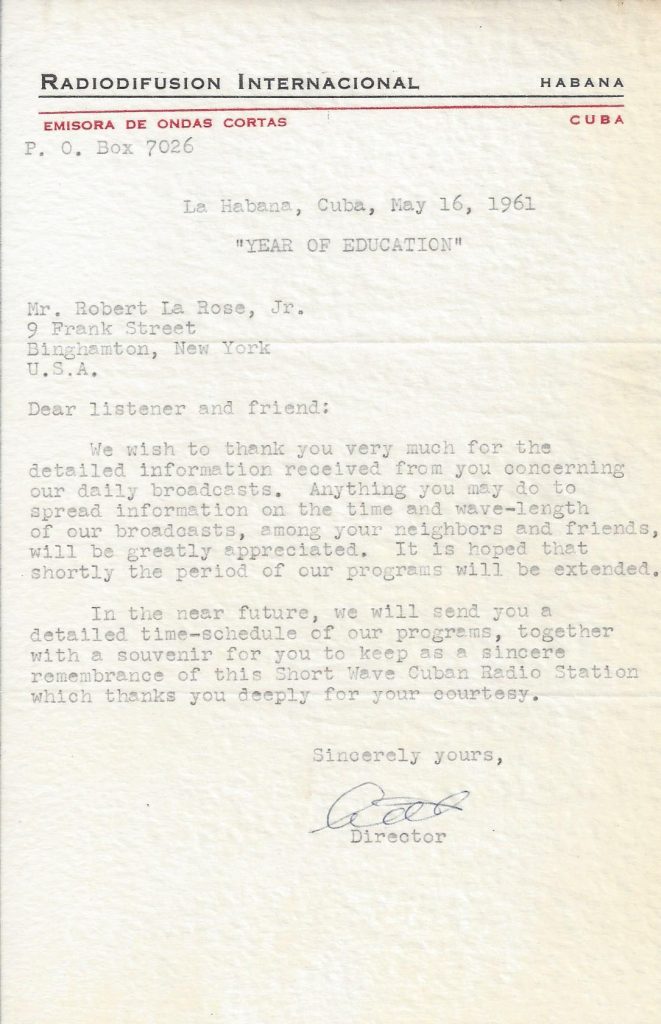
WRMI transmitter building with windows and doors boarded up in anticipation of the arrival of Hurricane Irma.
(Source: WRMI on Facebook)
Dear WRMI Friends, Colleagues and Clients:
I am writing this at 0400 UTC Sunday, September 10. Here in Okeechobee the winds are starting to pick up as Hurricane Irma heads to Florida.
The exact path of the hurricane continues to change somewhat, but it appears that the eye of Hurricane Irma will be passing a bit to the west of us, but we will still receive tropical storm force winds which are to the east-northeast of the storm. We will remain on the air with all of our transmitters as long as possible. However, once the winds get to a certain strength, our transmission lines will start flapping around and arching, which could cause serious damage to the transmitters and components. If that occurs, we will probably shut the transmitters down in order to avoid equipment damage until after the storm passes.
Our transmitter building itself is quite strong, and several members of our staff will be staying inside the building. But the hurricane could of course do damage to our antennas. We will hope for the best.
After the hurricane passes and winds die down, we would hope to be able to resume transmissions if we have electricity. However, realistically, we know that power outages generally occur in these situations, and they may last from hours to days or even weeks. We have a generator at our transmitter site, but it is designed to maintain our control room, lights and computers operational; it is not large enough to maintain our high-power transmitters on the air. So if the commercial power goes out, we will be off the air. We may be able to maintain one transmitter on the air at low power; this will likely be 9455 kHz, and this may not be possible until after the storm passes and the winds die down. If our Internet service remains functional, we should be able to maintain our live stream operational. This is the programming that is on 9955 kHz shortwave. You can hear it on our webpage, www.wrmi.net. Click on the audio player on the lower right side of our home page. You can also hear this stream on services such as TuneIn, Streema, Radio Garden, etc. (Just search for WRMI.)
We will try to keep everyone up to date on our status via our Facebook page, www.facebook.com/wrmiradio.
Thank you to everyone who has been contacting us with your thoughts and prayers. We look forward to being able to resume normal operations as soon as possible.
Best regards.
Jeff White
General Manager
WRMI Radio Miami International
10400 NW 240th Street
Okeechobee, Florida 34972 USA
Tel +1-305-559-9764
Fax +1-863-467-0185
www.wrmi.net
Many thanks to Jeff White for publishing this update.
I’m curious if anyone has been monitoring Radio Havana Cuba this morning. Rob Wagner posted the following update on Facebook yesterday morning as Cuba was getting battered by the full force of Irma:
Monitoring Cuba at 1110 UTC on Sept 9:
5025 CUBA. R. Rebelde – Bauta. At the height of Hurricane Irma, with a fat carrier and no audio from tune in at about 1000 UT till 1043 when suddenly audio came on. So perhaps power at the txer but not in the studio during that time. Appears to be all live crosses. The audio off again after 1105 till 1109. CNN says that Irma is right over Havana (north side of the island) right about now. So they are right in the thick of it.
If you have an update, please comment.
We’re wishing our many Florida, Georgia and SE US readers the very best as this particularly destructive storm passes over land. We hope our readers who have already been in the path of Irma have made it through safely.
Here at the SWLing Post HQ, in the mountains of western North Carolina, we’re expecting high winds and heavy rains even though the storm path has shifted further west. Much of this is due to our altitude which is relatively high for the region–near the ridge line. Sustained winds may be around 40 mph with gusts in excess based on the current forecast. These are wind speeds we can easily handle. Strong sustained winds and rain may persist until Thursday, however, which may mean power outages due to fallen trees. All in all, we feel very lucky.
Please feel free to share your hurricane report in the comments section.











